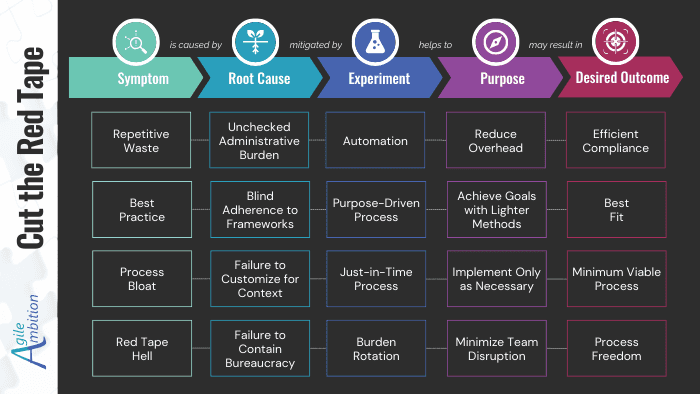Questioning the Rules: Cut the Red Tape

Process is like a traffic light. A well-placed one prevents chaos, but a pointless one wastes time. Do you know which kind your team is following?

Have you ever sat at a red light with no other cars in sight? You could go. You should go. But the rule says wait, so you do.
Your team may have rolled out Scrum or SAFe without knowing why. Maybe leadership dropped a mandate from the sky, assuming it would work just because “industry leaders” do it. But process for the sake of process doesn’t drive progress—it stalls it.
And the worst part? The people making these decisions aren’t sitting at the red light. They’re miles away, adjusting policies while you’re stuck, waiting for permission to move.
So, do you keep waiting? Or do you find a way through?
Try these four experiments to stop following rules that don’t serve you.
From Repetitive Waste to Efficient Compliance

Do you ever do something at work and think, Why am I even doing this? That’s repetitive waste—tasks done out of habit, not necessity. And they pile up fast, thanks to unchecked administrative burden.
Automation can help you eliminate this waste. And no, you don’t need an AI-powered, blockchain-infused solution. Every time you run a process that feels like busy work, tweak it. Make it just a little easier. These small, strategic automations add up.
Executive leadership requires my team to add story points to every backlog item, even though we don’t use them for planning. So we don’t fight it—we default every story to 1 at creation. Mandate met. No friction.
Every process you touch, ask: Does this actually need me? If the answer is no, cut it or automate it.
Before you know it, you’ve moved from repetitive waste to efficient compliance—not by fighting bureaucracy, but by outsmarting it.
Automation eliminates busy work, reduces overhead, and lets teams focus on valuable work.
🤔 What’s one process you follow just because “that’s how it’s always been done”?
From Best Practice to Best Fit

Have you ever treated best practices like a cheat code? Just follow what the FANG companies do, and success will follow—right?
Except, it doesn’t work like that. Blind adherence to frameworks ignores context. What works for Google won’t necessarily work for you.
That’s where Purpose-Driven Process comes in. If story points help you plan, great. If Monte Carlo works better, why force estimates that add no value? The key isn’t copying someone else’s process—it’s achieving the same goal with lighter methods.
Leadership cares about results, not rituals. If you deliver, no one will ask if you followed “best practices” to do it. That’s how you move from best practice to best fit—where your process serves you, not the other way around.
Purpose-Driven Process uncovers intent, allowing more innovative, tailored solutions over rigid mandates.
🤔 If your team had complete autonomy, would you still choose to do the same processes the same way? Why or why not?
From Process Bloat to Minimum Viable Process

The problem with frameworks? They look complete on a slide deck. So teams adopt the whole thing, only to find themselves buried in process bloat—meetings, checklists, and rituals that feel more performative than productive.
This happens when there’s a Failure to Customize for Context—treating the process like a pre-assembled kit instead of a toolbox.
Use Just-in-Time Process—only introduce what solves a real problem. If a meeting doesn’t drive decisions, cut it. If a backlog refinement session isn’t needed every Sprint, skip it. Implement only as necessary.
Teams that take this approach shift from process bloat to minimum viable process, where every rule earns its place.
Just-in-Time Process ensures your team solves real problems, not just follows rules.
🤔 What processes are you following only because they were part of a framework?
From Red Tape Hell to Process Freedom

You can’t automate everything. Some processes refuse to die. When you’re stuck in red tape hell, trapped by failure to contain bureaucracy, the worst thing you can do is let everyone suffer equally.
Use Burden Rotation—rotate one person to shield the team. Then, rotate the responsibility to avoid burnout. This experiment isn’t about throwing someone under the bus—it’s about minimizing team disruption while keeping the work flowing.
This approach isn’t surrender—it’s strategy. It minimizes disruption so you and your team can stay focused on real work. Over time, this kind of smart containment builds toward process freedom—where bureaucracy is a nuisance, not a team-wide catastrophe.
Burden Rotation prevents burnout, minimizes disruption, and keeps bureaucracy from stalling progress.
🤔 How can you distribute unavoidable process burdens without disrupting meaningful work?
TLDR
Process should guide, not control. Stop following rules for the sake of it—eliminate waste, challenge assumptions, and streamline workflows to reclaim team autonomy.

Don’t stay stuck at a red light—pick one experiment and get moving this Sprint!
Share
Table Of Contents
Fuel an Idea
Every week, I break down complex ideas, strip away the fluff, and give you experiments to turn knowledge into skills.
If that’s worth a coffee, consider fueling the next big insight.
No pressure. No guilt trips. Just impact.
Buy Me a CoffeeRelated Posts
Quick Links
Legal Stuff

